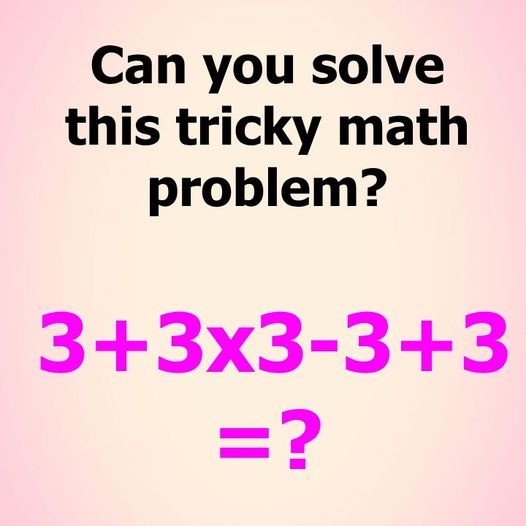Lately, math puzzles like this one have been going viral online, challenging people to put their arithmetic skills to the test. These types of problems are deceptively simple, often leading to heated debates as people try to prove their answers. Unlike crossword puzzles or Sudoku, which rely on word patterns and logical sequences, math problems require a specific approach using fundamental rules of arithmetic. The key to solving them lies in whether you remember the basic order of operations you learned back in school.

If you’ve ever sat in a middle or high school math class, you might recognize problems like this. But the real challenge comes when trying to recall those long-forgotten math rules. Without regular practice, many people forget the correct method for solving these types of equations. That’s what makes these puzzles so interesting—they take us back to the math drills of our school days, making us rethink how we approach even the simplest calculations.
Before we go any further, take a moment to solve this problem yourself:
3 + 3 × 3 – 3 + 3
At first glance, it may seem straightforward, but many people get it wrong by rushing through the steps incorrectly. The key to solving this correctly is remembering the order of operations, a rule that determines the sequence in which different parts of an equation should be solved.
Understanding the Order of Operations
When solving an equation with multiple operations, following the correct sequence is crucial. You may recall learning PEMDAS in school, an acronym that helps organize the steps:
- Parentheses first
- Exponents second
- Multiplication and Division (from left to right)
- Addition and Subtraction (from left to right)
This rule ensures that calculations are performed correctly and consistently. Many mistakes happen when people instinctively solve the equation from left to right without prioritizing multiplication over addition and subtraction.
Step-by-Step Solution
Now, let’s go through the problem using the correct order of operations.
- First, identify the multiplication: 3 × 3 = 9
- Rewrite the equation with this result: 3 + 9 – 3 + 3
- Solve the equation from left to right:
- 3 + 9 = 12
- 12 – 3 = 9
- 9 + 3 = 12
The correct answer is 12.
Why Do So Many People Get It Wrong?
One of the most common mistakes is solving the equation from left to right without considering the priority of multiplication over addition and subtraction. For example, if someone mistakenly adds 3 + 3 first, they get 6, then multiply by 3, which leads to the wrong answer. This miscalculation explains why so many people are convinced their incorrect answer is right.
Math problems like this are great because they highlight how our brains process numbers and rules. Even a small mistake in the sequence can completely change the outcome. This is why math puzzles continue to be fun and engaging—each problem challenges our ability to recall basic math concepts and apply them correctly.
Why These Puzzles Are So Popular
Math challenges like this one have gained massive popularity online, with people debating answers in comment sections and trying to prove their solutions. The reason? They force us to think critically. Even people who don’t typically enjoy math find themselves drawn into the challenge, eager to see if they can get the right answer.
Additionally, solving math problems can be beneficial for brain function. Research has shown that engaging in numerical puzzles helps improve cognitive skills, problem-solving abilities, and overall mental agility. Just like physical exercise strengthens the body, mental challenges keep the brain sharp.
The Joy of Getting It Right
If you solved the problem correctly, congratulations! You successfully applied the correct order of operations and found the right answer. If you didn’t, don’t be discouraged—math problems like these are a great way to brush up on old skills and improve your ability to tackle similar challenges in the future.
Challenge Your Friends and Family
Want to make it even more fun? Share this problem with your friends, family, or coworkers and see how they approach it. These types of puzzles spark great discussions and friendly debates. Some people may insist they’re right, only to be surprised when they realize their mistake.
Final Thoughts
Math may not be everyone’s favorite subject, but these brain teasers remind us why it’s such an essential skill. Whether it’s calculating grocery expenses, budgeting for bills, or figuring out measurements in cooking, math is all around us. Keeping these skills sharp not only helps with everyday tasks but also strengthens logical thinking.
So next time you see a math challenge like this, take a few moments to solve it carefully. Remember the order of operations, double-check your work, and enjoy the process. Who knows? You might just rediscover your love for problem-solving along the way!





